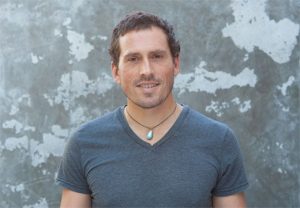There’s an old joke that makes it way around Silicon Valley, gifted to every new arrival when they hit their lowest points: “As a startup CEO, I slept like a baby. I woke up every 2 hours and cried.”
Like all good jokes, it contains more than kernel of truth. It makes you laugh—but it cuts, too. Anyone in the startup world—founder or not, CEO or not—can relate it to it. We all know the stresses, the grind, the oh-my-god-can-we-do-this type fear that comes with doing something new, with building something that hasn’t existed before. The fear doesn’t come in stages, either. It’s more like the background roar of the work. You’re hustling, pitching, scaling, and then, if you’re successful, you do it all over again.
It’s what we signed up for. We know the upside. We want to build. But one of the central things lacking in all that doing and building, I’ve found, is time for thinking and reflection. I know I am guilty of this: I spend so much time swimming in a single direction that I rarely pause to lift my head above water, take a breath, and take stock.
That great marketing campaign that you ran? The poor hiring decision? The unforeseen risks? That pesky legal issue? All these are opportunities to learn. But if we are always doing, doing, doing, these never become the lessons that can be codified and then passed to others in the community, let alone ones that we really let sink in.
I recently had occasion to do exactly that: to actually think for a minute about how we got to where we are. And I think there are some things we’ve done at Thrive Market that are different, the origins of which might benefit other people who are on or about to be on the startup gauntlet. Here’s what we learned from doing financing our own way:
Trending: Navy SEAL Secrets for High Performance Under Pressure
1. Say it out loud: You will get rejected. The world will go on. It’s just part of the process.
After hundreds of miles, dozens of meetings, and way too many nights away from home, we had nothing to show for it. Rejected by over 20 of the country’s top VC firms. If there was a moment to hang it all up, this would have been it. After all, if all of these smart investors didn’t think we were worth taking a chance on, why did we think we were?
The investors may have had a point. This was a highly competitive, $100 billion industry with giant players like Amazon and Whole Foods. Could my co-CEO and I could execute on the e-commerce operational and logistical elements efficiently and at scale? Were our financial projections sensible?
Necessity breeds invention. And we had some real necessity. So we decided to go our own way. We developed a model of funding that, in the end, was better for us than a traditional VC-based model. But the point isn’t the model itself: The point is that rejection is, in some ways, almost inevitable. It’s easy for a story like this to lapse into cliche. So let me disabuse you of that: Rejection isn’t fun. It’s not a line on a resume. When you’re in it, you don’t imagine there will be light at the end of the tunnel; there’s just miles and miles of tunnel. But sometimes you can find your way through. I like to remind myself of that Elon Musk quip when he was asked about his optimism: “Optimism, pessimism, fuck that; we’re going to make it happen. As God is my bloody witness, I’m hell-bent on making it work.” Do you believe in the mission? Then keep going. Push through.
2. VC funding isn’t the only way to raise money.
For a long time, in interminable VC meeting after meeting, we began to hatch and nurture a small plan. What if our investors weren’t just these nameless, faceless VC firms? What if they were real flesh-and-blood people, outsiders to the funding game, maybe, but insiders to the kind of business we wanted to build? When we allowed ourselves to dream wildly about our business, we always imagined that our investors were people aligned with our values, people who could take an active role in the business. By the point of being rejected a couple dozen times, we knew something else, too: Most VCs weren’t the target demographic for health and wellness, didn’t, represent our customer base, and didn’t understand the market.
So we went out looking for people who did. We found, in the end, over 300 stakeholder-investors: People who were willing to put their money where their mouth was—and to lend us their mouths from time to time too! This is how we were able to raise our initial seed round with investors like Deepak Chopra, Tony Robbins and Mark Sisson. We were later able to raise from individual investors who founded well-known brands such as Stonyfield Farm, TOMS Shoes, Zico Coconut Water and Zulily. If we hadn’t been rejected by so many VC firms, we probably wouldn’t have gone this route, but doing so has transformed our business. Our stakeholder investors care about our success because they care about the mission. They have a financial stake, sure, but they are actually motivated by finding ways to get health and wellness products to more people, more cheaply, and more easily.
Here’s the truth: Getting funding these days is considered a media-worthy accomplishment. It’s a process that sucks a lot of oxygen out of the room. It generates buzz. It makes founders feel they’ve arrived. But have they? A VC fund giving you money is them giving you, effectively, a loan. A loan that requires repayment. And so it’s worth keeping that in mind when you hear stories of your friend’s start-up getting funded. It’s an accomplishment, sure, but there’s more than one way to get there. Figure out if a passive institutional investor like a VC is right for you, or if you want to have more active partners who have real skin in the game. Only you can answer that question, but the reflection will be worth it.
Trending: How to Make Menopause the Best Time of Your Life
3. Curate your investors
Success attracts investors like moth to a flame. Rather than the problem of figuring out how to raise money, we’ve now run up against the opposite issue: how to turn the wrong money away.
Wrong money? Isn’t that a contradiction in terms? Nope. We’re very, very deliberate about adding partners, and we only choose to work with investors who add to the business, care about its values, and who we enjoy working with. We’re fortunate in being able to be patient and flexible with our funding, but, even in a universe in which we could raise millions of dollars on a sky-high, totally unrealistic valuation, we have chosen to proceed slowly and methodically and with people on the journey who we actually want as investors–not just for their ability to write checks.
Be ruthless in selecting who you work with. We have chosen to only work with people who truly believe in our mission and who can take a more active role. And whatever situation you’re in, manage with resilience and patience in mind. The less you need the money, the better off you’ll be strategically.
4. Be respectful (aka, don’t burn bridges)
It’s a small world. It’s easy to take the investment process personally. Investors wield a lot of power and can be brusque or even disrespectful. By maintaining good relationships, especially with investors who may initially turn you down, you’ll set yourself up for later rounds when there is success in the business and you can take on investment with better terms. Keep investors apprised of your success and be thoughtful and respectful, even if it’s not being reciprocated.
***
Trending: Microsoft, Google, and Beyond: What Business at the Cutting-Edge of AI Looks Like
Much of what is above we figured out by hook and crook. It was painful, at times, and my hope in putting it all down on paper is that you can avoid some of the pain we had to experience.
It’s usually at this point in an essay that a CEO has to reach for some grand moral to the story. Sorry to disappoint, but there isn’t one. That’s one of the great virtues of being in a start-up: There aren’t clear endings to the story. What I can tell you is what I tell every one of our new employees, and yes, every one of our new investors: Belief in our mission is what keeps us going.
How badly do you believe in yours?
Gunnar Lovelace is the founder and co-CEO of Thrive Market, an online wholesale buying club on a mission to make healthy living easy and affordable for every American family.































